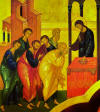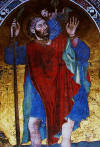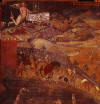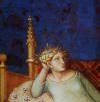Artists Alphabetically Symbolism 50 Greatest Paintings Art Movements Greatest Painters
Principle Artists Associated with the the Sienese School of Painting
Examples of Sienese painting (click to Enlarge)
Important Italian Painters of the Sienese School Listed AlphabeticallyTaddeo di Bartolo (1362-1422) Italian, Sienese, Early Renaissance
Giovanni Antonio Bazzi (1477-1548) Italian, Sienese, High Renaissance
Domenico di Pace Beccafumi 1486-1551) Italian, Sienese, Renaissance
Duccio di Buoninsegna (1255-1319) Italian, Sienese, Early Renaissance
Giovanni di Paolo di Grazia (1403-1483) Italian, Sienese, Early Renaissance
Sano di Pietro (1406-1481) Italian, Sienese, Early Renaissance
Ambrogio Lorenzetti (1290-1348) Italian, Sienese, Early Renaissance
Pietro Lorenzetti (1280-1348) Italian, Sienese, Early Renaissance
Coppo di Marcovaldo (1225-1274) Italian, Sienese, Early Renaissance
Simone Martini (1280-1344) Italian, Sienese, Early Renaissance
Lippo Memmi (1285 -1361) Italian, Sienese, Early Renaissance
Giovanni di Paolo (1399-1482) Italian, Sienese, Renaissance
Sassetta (1394-1450) Italian, Sienese, Early Renaissance
Sodoma (1477-1548) Italian, Sienese, High Renaissance
☼☼☼☼☼
While Byzantine art is stormy and rigid, Sienese painting is youthful, lovely, and graceful. The prevailing characteristic being slender, supple grace. It seems as if the stone vaults of the churches had suddenly become transparent, and the eyes gazed upwards towards heaven, where tender ethereal beings, singing and praising the Highest, lived in eternal youth and lovingly gazed down upon mankind. Early Sienese Painters explored a mystical path that led to a new world of beauty and spirituality. They became renown for a lyricism and sensitivity to color that became the foundation of Sienese painting.
The greatest examples of Sienese painting are housed in the famous Civic Museum inside the Palazzo Pubblico overlooking the Piazza del Campo. The Palazzo Pubblico was built in the early 1300s by the Government of Nove. It is a masterpiece of medieval urban architecture. In the Great Council Hall there are extraordinary frescoes by Martini depicting a beautiful Maestą and next door, in the Hall of Nine there is the amazing fresco cycle by Ambrogio Lorenzetti showing the Allegory and Effects of Good and Bad Government.Require more facts and information about Principle Painters of the Sienese School? Poke around every nook and cranny of the known universe for information this subject. Search Here
If you feel you have worthwhile information you would like to contribute we would love to hear from you. We collect essential biographical information and artist quotes from folks all over the globe and appreciate your participation. When submitting please, if possible, site the source and provide English translation. Please submit your comment to the editor, via e-mail and if possible site the source. Thank you!
copyright 20003 - historyofpainters.com
© HistoryofPainters.com If you like this page and wish to share
it, you are welcome to link to it, with our thanks.








